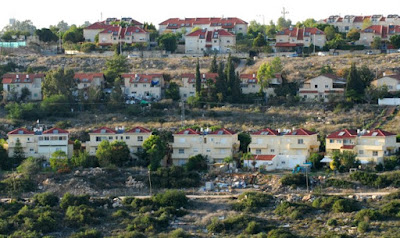by Matanel Eitan, inn.co.il/besheva, translated by Hillel Fendel
The Jewish towns and settlement enterprise in Shomron (Samaria) is growing and thriving – but the challenge facing local and national government is whether the transportation infrastructures can keep pace.
For instance: The Interior Ministry recently decided that the large town of Karnei Shomron – whose populace includes many immigrants from English-speaking countries – will now incorporate the settlement of Maaleh Shomron to the west. The town will thus include four "boroughs:" Karnei Shomron, N'vei Menachem, Ginot Shomron, and Maaleh Shomron. Ministry officials said that the new unified municipality "is expected to strengthen the towns, increase the level of services and investment in the populace, and enhance and develop quality of life in the entire area."
The move increases the populace of Karnei by over 10%, to about 10,000. That is, it could soon become an official city in Israel – but only one small road leads to it!
In addition, south of Maaleh Shomron and north of Elkanah, planning has already begun for a new hareidi city in the Shomron, to be named Dorot Illit – for what is hoped to be tens of thousands of residents.
If you consult a map of the area, such as https://www.google.com/maps/place/Elkana/@32.1777459,34.9453895,13.25z/data=!4m5!3m4!1s0x151d30073fbd6ecd:0x17bd5a9fa0ef310f!8m2!3d32.110566!4d35.032054, you will see that the highway system at present is not only insufficient for the expected growth, it is non-existent. In fact, Route 5, which serves the city of Ariel and neighboring towns, is the only 4-lane east-west highway in Yehuda and Shomron!
To the north of Route 5 is Route 55, which serves Karnei and vicinity, but is only two lanes wide.
Dorot Illit investors and Karnei Shomron Mayor Yigal Lahav toured the area of the planned new city two weeks ago, and the acute problem of the paltry transportation infrastructures was presented in bold relief. Lahav is well aware that the Transportation Ministry is on the verge of presenting its next five-year plan – and is concerned that the Shomron will not play a major role therein. The plan must invest in at least three new or enhanced east-west Shomron highways, Lahav says. He emphasizes that it's all up to a certain strong Judea/Samaria supporter, Transportation Minister Miri Regev.
Lahav has some long-standing gripes: "In terms of road infrastructures, Judea and Samaria (Yesha) has not been taken into account in any program or map for the past 40 years. Bypass roads and traffic circles have been built, but what about strategic routes? Nothing is happening like that which led to the paving of Route 5, and if the late Ariel Mayor Ron Nachman had not pushed for it, we would not be seeing today the thriving development of Ariel and the nearby industrial zones that exists."
Asked how it is that the planning authorities don't understand this, Lahav said, "Generally everyone knows that new roads bring development and population, but unfortunately in the Shomron it seems to be the opposite. It's the settlements that gradually bring the new roads, which is not the way it should be in the year 2020."
He decried the fact that Route 5 is alone in transporting most of the east-west traffic. "Even the IDF representative who took part in a recent meeting agreed with our claims, and said that a 4-lane highway must be built alongside Route 55. It is simply illogical that 2.5 million Jews and Arabs in the area have such poor roadway infrastructures."
"Our highways are considered fairly safe," according to Lahav, "but that's because the Arab car accidents haven't been counted in the statistics! I hope that we resolved that issue in our last meeting with the Public Security and Transportation Ministers, and that now those accidents will be included as well, because the gap between the reported accidents and those that actually happen is tenfold."
The problem is very deep-seated, Mayor Lahav feels. "The State takes care only of what's between the Mediterranean Sea and Route 6 [the north-south highway roughly 15 kilometers east of the sea]. Official state publications show that the gas pipeline doesn't pass through Yesha, power stations aren't located in Yesha, and official Netivei Yisrael highways don't pass through Yesha. I have no doubt that the government echelons want very much to help, but I believe that the administrative clerks try to impede our development. We're simply not invited to many of the planning meetings."
Lahav says that there has been an increase of tens of percentages in the number of Shomron residents over the past four years, but the road systems are still not being addressed on the macro level. "In 20 years we will have at least the population of Kfar Sava plus half of Raanana [the main cities to our west]. They enjoy Route 6, Route 4, Route 2 [going north to south], plus 531 and soon a new 551. And what do we have? Two lanes of Route 55. How is it that the planning authorities don't wake up to this? We are citizens, and we should not have to fight to receive appropriate roadways."
It's all up to Miri Regev, Lahav feels, but he sounds cautiously optimistic that she will, in fact, recognize the importance of the challenge. "Her predecessor, Betzalel Smotrich, understood the needs, but he wasn't in the job long enough to get it done [because new elections were called]. Regev must continue to be a leader who gets things done. In addition to more east-west routes, an exit-entry must be added on Highway 6 to Route 55, for the benefit of both the Shomron and Sharon regions – as all local municipal leaders, plus the IDF, agree. Regev's signature on these plans is super-critical for the Yesha settlement enterprise."
